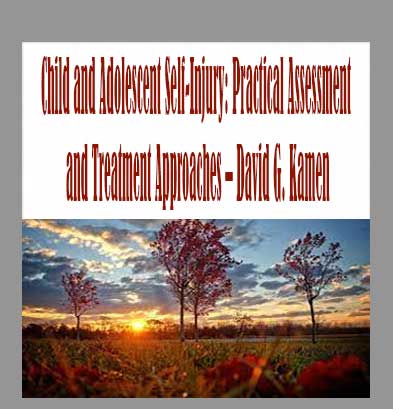Child and Adolescent Self-Injury: Practical Assessment and Treatment Approaches – David G. Kamen
Description
Child and Adolescent Self-Injury: Practical Assessment and Treatment Approaches – David G. Kamen download , Child and Adolescent Self-Injury: Practical Assessment and Treatment Approaches – David G. Kamen review , Child and Adolescent Self-Injury: Practical Assessment and Treatment Approaches – David G. Kamen free
Child and Adolescent Self-Injury: Practical Assessment and Treatment Approaches – David G. Kamen
Children and adolescents who deliberately inflict physical pain and injury to their bodies vary in terms of their motives and self-harming methods. Feeling shame and embarrassment, these children may privately console themselves, or befriend other self-injurious peers—which can further intensify the lethality and suicidal intent of their acts. As a result professionals who work with youth who self-injure find it to be one of the most challenging of psychological and behavioral issues.
Mental health professionals, pediatricians, school counselors and teachers, and youth workers have all conveyed that they feel ill-equipped to help these children. Further still, self-harming children may be experiencing any number of psychiatric disorders—from Major Depressive Disorder, to Obsessive-Compulsive Disorder, to bulimia and anorexia, to alcohol and substance abuse.
This recording will thoroughly educate mental and medical health professionals, school counselors and teachers about the assessment and treatment of youth self-injury. Evidenced-based reviews, complete with case examples, will explain the theoretical, historical and cultural reasons for this problem. Practical approaches for individual and group psychotherapy, with resources to help professionals advocate for these children, will be offered.
To help you formulate a comprehensive treatment plan, specific interview questionnaires and note-taking methods will be discussed. Well-established motivational interviewing, family therapy and play therapy techniques will be covered with step-by-step instruction and demonstration. Watch this digital seminar and build your confidence that you can identify and effectively treat this damaging condition.
- Characterize how cultural and theoretical perspectives on youth self-injury inform clinical practice.
- Distinguish between suicidal, para-suicidal and non-suicidal self-injurious behavior in children and adolescents.
- Communicate how emergency triage, behavioral functional analysis, clinical interviews and mental status examinations are conducted with children who self-injure.
- Provide the names of 2 risk factors that can contribute to an increased potential of self-harm in children.
- Establish how specific clinical interview questionnaires and note-taking guides can be used to evaluate and treat children who self-injure.
- Articulate how techniques from motivational interviewing, exposure therapy, journaling, and play therapy can be employed with youth who self-injure.
Get Child and Adolescent Self-Injury: Practical Assessment and Treatment Approaches of author David G. Kamen
The Theory, History and Cultural Origins of Youth Self-Injury
- History of youth self-injury, with cross-cultural comparisons of the problem
- Cognitive-behavioral, psychodynamic, family systems, feminist and neuropsychological perspectives on youth self-injury
- Comparative analysis of suicidal, para-suicidal and non-suicidal self-injury
Empirical Review on Youth Self-Injury
- Epidemic facts on the incidence and prevalence of youth self-injury
- Psychiatric and medical comorbidity associated with youth self-injury, including:
- Reactive Attachment disorder
- Obsessive-Compulsive Disorder
- Post-Traumatic Stress Disorder
- Major Depressive Disorder
- Disruptive Behavior Disorders
- Case study review
Signs of Self-Injury
- Types of self-injurious behaviors in children and adolescence
- Behaviors that should be a “red flag”
- Who is most at risk of developing self-injurious behaviors?
- Clinical onset, development and prognosis of injurious behaviors
- Individual emotional and cognitive causes of self-injurious behavior
- Deep psychological sources of self-injury, including masochism and narcissism
- Family conflict, peer pressure and social contagion that causes self-injury
The Clinical Assessment of Youth Self-Injury
- General diagnostic interview and mental status examination
- Suicidal and lethality risk assessment
- Personality assessment
- Norm-referenced youth self-injury inventories for:
- objectively measuring self-injury risk and protective factors
- suicidal thoughts, emotions and attitudes
- Collateral interviews with parents, teachers and other health care professionals
Diagnosing self-injurious behavior
- Mood Disorders
- Obsessive-Compulsive Disorder
- Post-Traumatic Stress Disorder
- Attachment Disorder
- Borderline Personality Disorder
- Bipolar Disorder
The Treatment of Youth Self-Injury
- Ethical considerations, including confidentiality and duty-to-warn policies
- Treating the behavior as an addiction and as an obsessive-compulsive feature
- The 4-Step Assessment and Treatment Approach
- emergency triage and case conceptualization
- functional analysis of self-injury behaviors and reinforcements
- Motivational Interviewing—to treat self-injury as an addiction
- Exposure Therapy—to treat obsessive-compulsive features of self-injury
- Counseling Techniques
- “No talk” Play therapy
- cognitive-behavioral
- psychodynamic
- family systems counseling
- group psychotherapy approaches
- dynamic
- existential
- cognitive-behavioral
- Pharmacotherapy
- commonly prescribed medications
- when to send out a referral
- contraindications
- Coordination of care with educators, medical and mental health care professionals
- developing a collaborative team of professionals
- relapse prevention
- Tips for professional self-care—to prevent you from getting vicarious traumatization
- Examination of community resources and references
What You Will Learn
- Learn the epidemic facts on youth self-injury
- Examine the historical, cultural and theoretical perspectives on youth self-injury
- Outline the spectrum of self-injurious behaviors in children and adolescents
- Recognize and be able to distinguish between suicidal, para-suicidal and non-suicidal self-injurious behavior in children and adolescents
- Discuss self-injury etiology, assessment and intervention/prevention issues
- Understand the psychiatric disorders of the children who self-injure
- Examine evidence-based reviews and practical approaches for the hospital, therapy room, school, and community
- Discover how to use play therapy, including art therapy, sand-tray therapy, journaling methods, music and crafts to build self-esteem and confidence in youth who self-injure
- Discover Internet resources to further develop self-injury assessment and therapy skills demonstrated during this seminar
- Discover ethical risk-management methods, to effectively advocate for youth who self-injure, to minimize professional risks and maximize outcome for your clients
- Discuss case studies relevant to the treatment of self-injury
Frequently Asked Questions:
- Innovative Business Model:
- Embrace the reality of a genuine business! Our approach involves forming a group buy, where we collectively share the costs among members. Using these funds, we purchase sought-after courses from sale pages and make them accessible to individuals facing financial constraints. Despite potential reservations from the authors, our customers appreciate the affordability and accessibility we provide.
- The Legal Landscape: Yes and No:
- The legality of our operations falls into a gray area. While we lack explicit approval from the course authors for resale, there’s a technicality at play. When procuring the course, the author didn’t specify any restrictions on resale. This legal nuance presents both an opportunity for us and a boon for those seeking budget-friendly access.
- Quality Assurance: Unveiling the Real Deal:
- Delving into the heart of the matter – quality. Acquiring the course directly from the sale page ensures that all documents and materials are identical to those obtained through conventional means. However, our differentiator lies in going beyond personal study; we take an extra step by reselling. It’s important to note that we are not the official course providers, meaning certain premium services aren’t included in our package:
- No coaching calls or scheduled sessions with the author.
- No access to the author’s private Facebook group or web portal.
- No entry to the author’s exclusive membership forum.
- No direct email support from the author or their team.
We operate independently, aiming to bridge the affordability gap without the additional services offered by official course channels. Your understanding of our unique approach is greatly appreciated.
- Delving into the heart of the matter – quality. Acquiring the course directly from the sale page ensures that all documents and materials are identical to those obtained through conventional means. However, our differentiator lies in going beyond personal study; we take an extra step by reselling. It’s important to note that we are not the official course providers, meaning certain premium services aren’t included in our package:
Refund is acceptable:
- Firstly, item is not as explained
- Secondly, Item do not work the way it should.
- Thirdly, and most importantly, support extension can not be used.
Thank you for choosing us! We’re so happy that you feel comfortable enough with us to forward your business here.
- Innovative Business Model:









Reviews
There are no reviews yet.